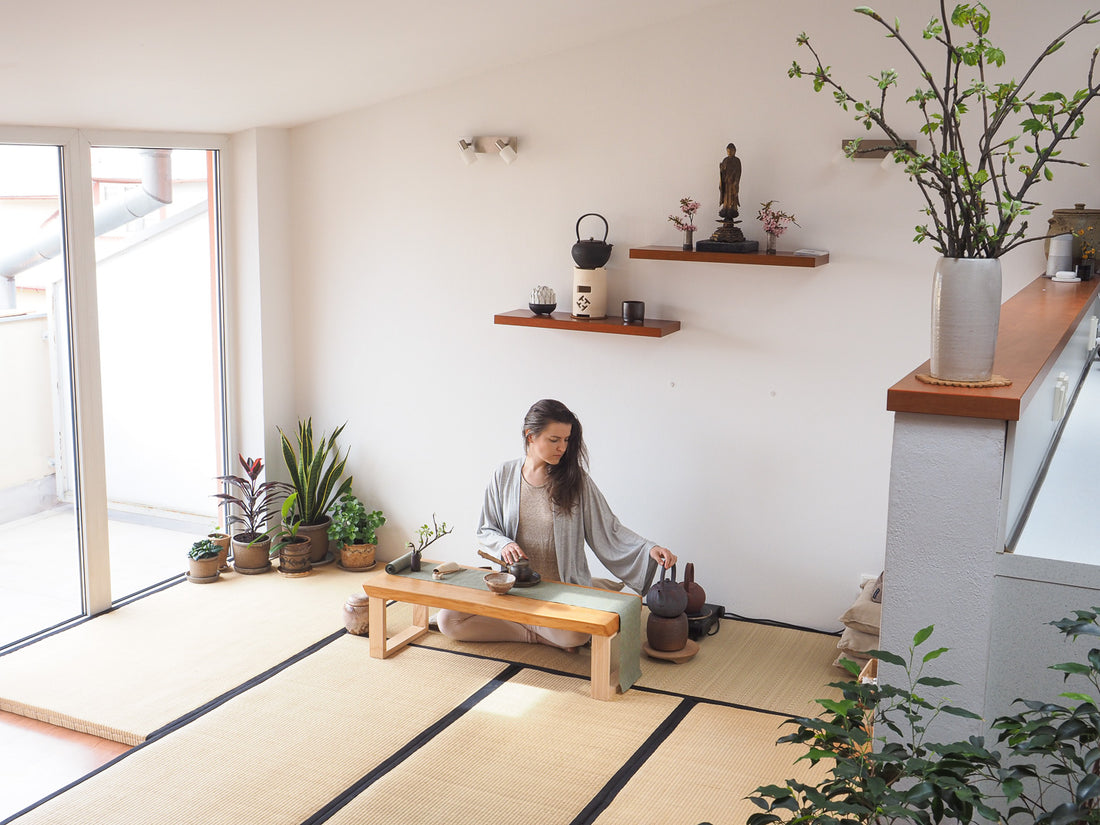
Sanctuary
My article about creating a dreamy tea space that will nourish your tea practice and become a perfect tool for serving tea daily as a ritual to yourself and others in November issue 2021 in one of the best tea magazines of our times Global Tea Hut which is embracing a holistic approach to tea culture. A magazine full of tea history, lore, processing techniques and heritage, as well as spiritual aspects of Cha Dao.
For this month, we have a gorgeous, inspiring and insightful article on creating a tea space at home by our very own Raneta. Not only is she a gifted Chajin, but she is also an amazing artist, photographer and creator of chaxi accoutrements. She lived at the Center for more than a year and discusses how she has taken what she learned and applied it to her life in the world, making her home into a sanctuary for tea and practice. A bit of focus on our homes, our tea spaces and our tea practice can change lives. At the end of the article, we felt like we couldn’t wait to visit her and join her for tea in her temple.
Sanctuary
The home of a Chajin is a sanctuary, a safe island in the ocean of modern busy lives. I haven’t been at any tea house for a year because of the pandemic and lockdown here in Europe, and I am very grateful to my previous self, who created a tea space at home that has served as a reminder of what is important to me every day. I want to share some simple steps you can take to help yourself create a tea retreat and sanctuary at home and what I learned along the way.
Five years ago, I went to Taiwan for a year-long internship as a photographer for this very cool magazine which you now hold in your hands. Everything at the Hut is organized the way I like it: beautiful tea rooms, fresh spring water for tea, lessons on lighting charcoal, daily routine with meditation twice a day, healthy eating, healthy living and so on. I loved everything, from the fresh flowers on the altars to the Buddha sitting in the middle of the koi fishpond. Things were set up like you’d find in a tea temple that was lost in time, where everything is a little bit idealistic—but damn, that’s exactly what I needed! In the normal outside world, space rockets were launched and bitcoin appeared, and in the Hut we had an hour-long trip to the temple on top of the mountain to fetch spring water for tea. Life was rich, but completely different over there. The essence of Tea for me is a pure simple life in harmony with Nature; it is awareness, attentiveness in the performance of every action and presence in the moment.

Honestly, returning to the ordinary world was not easy for me. Life in the city follows a different rhythm, and it is very easy to slip back into bustle, haste, worries about paying bills and taxes, etc. And living surrounded by people for whom most of what I do is absolutely pointless was also quite challenging at the beginning. Why boil water over charcoal when an electric kettle will boil it in a couple of seconds? Why use such a strange bowl when we have mugs? Why do you want to go so far for water when you can order water delivered? Of course, I can answer all these questions, but it is much easier to live in a space that is tuned up and with people who understand.
After I returned from Taiwan and realized that I wanted to experience peace and joy every day of my life, whether I’m in the Hut or not, I knew I needed to create my own tea sanctuary at home. I asked myself a question: What was cool in my favorite Tea Temple, and what principles from it can I adopt? Over the past four years, I have moved to a new country three times and created three tea rooms from scratch. So, I want to tell you about the basic principles that I have followed. I hope they will help you in your tea journey and encourage you to deepen your practice.

Declutter. Things that fill the space fill the mind as well. Therefore, it is important to clean the space and let go of stuff that doesn’t serve me anymore— everything that was important once upon a time, but now there is only sentimental attachment. It’s important to be surrounded by things that help me to remember my goals and waymarks. For me, a Buddha statue is a reminder of awareness, compassion and wisdom. A kettle on the brazier reminds me of the impermanence and fluidity of the moment. And the trophy for winning a dance competition as a child reminds me of the past that I already own, so I can let it go.
Make space. A special, designated place for tea helps a lot to tune into your practice. In my first tea room, I combined a studio, a yoga and meditation area and a tea space in one room. Over time, I realized that it is better to demarcate zones and allocate space that will accumulate energy and become a power field for tea practice. The best tea space starts to work right when I come in and light incense. My mind immediately tunes into my practice. I think about tea and water, about charcoal and what tea will be served on that day. When I combined different spaces into one, my mind seemed to jump from creative tasks to exercises, from tea to creativity and vice versa. And now that my tea space is entirely for tea, it feels like it has a lot more clarity, strength and discipline—and this feels like built-in energy to me.

Water is important. Tea is 99% water, so it is especially important to find a good source of fresh water for tea. The situation is different in different places. Now I am very fortunate, since there are a few springs with good water for tea around the place where I live. My friends from the Netherlands, where there is not much good water, have found an elegant solution: once every couple of weeks, they get together and travel in a big company to a neighboring country (Belgium) to fetch fresh spring water. They share tea in Nature, fill their cans, walk through the woods and then go back. For some, a two-hour trip to fetch water may seem like a lot of effort, but it’s really wonderful to go out into Nature to drink tea with other Chajin, enjoying the air, scenery and fellowship.
Clean. “80% of Cha Dao is cleaning,” as my teacher often says. Cleaning has become much easier since I got rid of unnecessary things and left only what speaks to my heart, helping me move in the direction that I want and to become the person I want to be. Fewer things means less cleaning. Living surrounded by a small number of very cool things has turned out to be much more joyful than having a lot of things. With space around the things we own, we appreciate them more and it is easier to be grateful for our abundance.

Celebrate every day. In Taiwan, we bought a lot of fresh flowers every week for the altars and tea spaces. I practiced doing chabana (the art of flower arranging for tea) and expressing the joy of life with flowers. Flowers were everywhere, from the kitchen altar to the toilets. I decided to do the same at home and it is impossible to count how many times I’ve heard my guests express delight that I do this. I love using flowers in tea ceremonies; it’s such a beautiful way to bring Nature into the space and is a reminder that we’re part of Nature ourselves. Flowers bring life to the ceremony and help to honor the occasion we’re coming together for.
Create a chaxi everyday. At first, I saw the chaxi (tea stage) as a piece of space around the teapot—where the tea is taking place. I used beautiful fabrics, flowers, carefully selected teaware and so on for my chaxi. Then it dawned on me that the whole room participates in a tea gathering: how it smells, how the light is reflected on the surfaces, what is on the shelves—all of this has the some effect on the state of mind of the guests and the brewer. Tea in an empty white room will be different from tea in a dark basement among dusty books and heavy carpets. Now I understand that a chaxi is the preparation, the room, the decorations, the tea and the ceremony—all of that is the stage. All those details change our experience and therefore our lives. Chaxi are always worth the effort.
These days I see my whole house as a tea temple. There are areas where I sleep, bathe and work, and there is a bit less tea in those spaces, of course, but in general, everything that I do in one way or another brings me to the tatami, to the tea table. In the tea world, we have the expression “ichi-go ichi-e (一茶一會),” or “one encounter, one chance,” which reminds us that everything is changing; such a moment as now has never been and will never be again. Therefore, we celebrate this moment—for example, by creating a chaxi. After all, to share tea you only need water and leaves, but to celebrate, you start with intention, then bring flowers, a favorite kettle, an elegant chabu (茶布); you wear nice clothes and make this time special. The more we put into our tea, the more we get out of it.
For the last year, home has become a power field for me. For some people, the heart of the house is the kitchen; for me as a Chajin, it is the tea space. This is the most thoughtful, beautiful and bright place, where it smells delicious, and it is always nice to hang out. I hope my insights and reflections on creating my life and tea space will help you look at your home from a different angle and create a tea sanctuary, a sacred space for yourself and others. May the tea spirit be with you...

